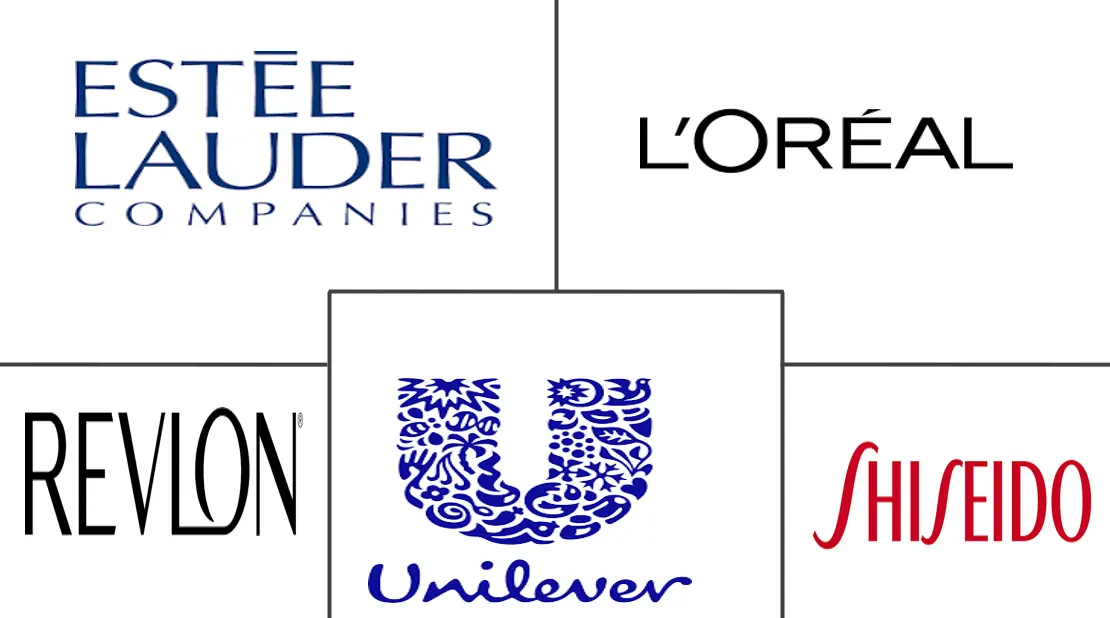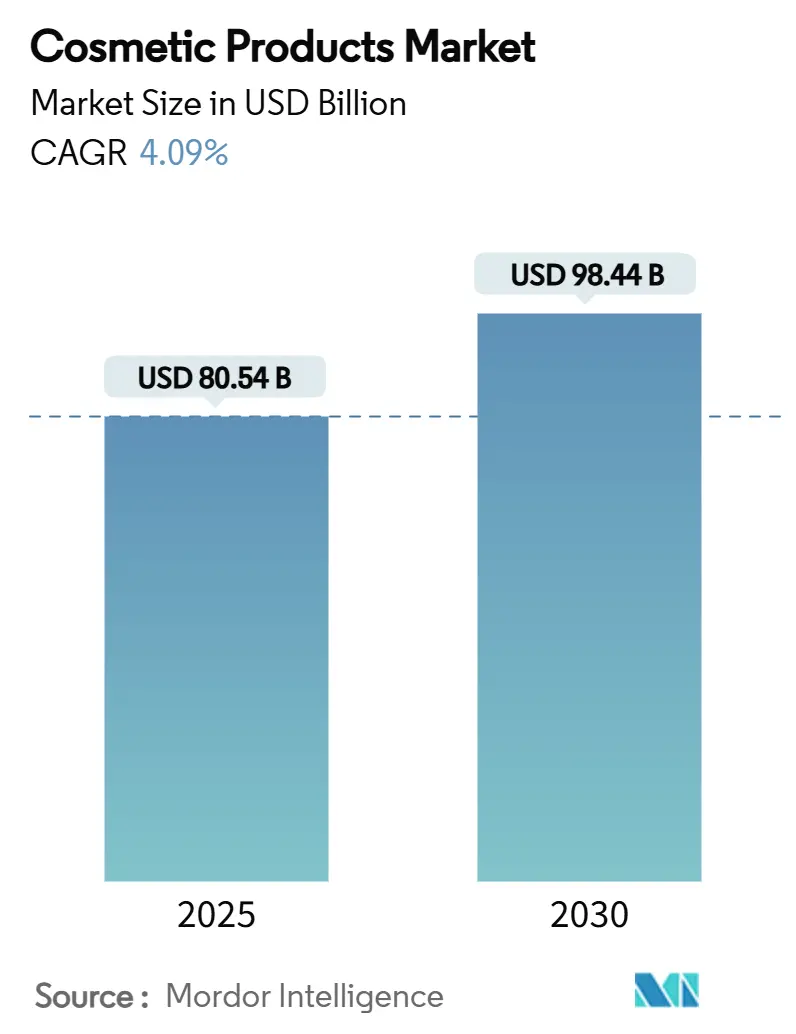
Cosmetic Products Market Analysis by Mordor Intelligence
The cosmetics market size is valued at USD 80.54 billion in 2025 and is forecast to reach USD 98.44 billion by 2030, reflecting a 4.09% CAGR over the period. This growth trajectory is primarily attributed to advancements in regulatory frameworks, the increasing adoption of sustainable and eco-friendly formulations, and the accelerated integration of digital technologies across various stages of the value chain, including research, production, and retail. In the United States, the Modernization of Cosmetics Regulation Act (MoCRA) has introduced mandatory facility registration, ensuring stricter compliance standards. Similarly, the European Union has implemented substance prohibitions to enhance product safety, while China has streamlined its ingredient approval processes to facilitate market entry. These regulatory developments are significantly influencing compliance costs, providing a competitive edge to companies with well-established regulatory infrastructures. Additionally, social media platforms are playing a pivotal role in driving brand engagement, enabling companies to connect with consumers more effectively. These trends are creating substantial revenue opportunities for businesses capable of integrating advanced technologies with transparent and ethical sourcing practices. From a regional perspective, the Asia-Pacific region is emerging as a dominant player, outpacing mature Western economies. This growth is fueled by the expansion of middle-class incomes and the widespread penetration of mobile commerce, which is transforming consumer purchasing behaviors and driving market expansion in the region.
Key Report Takeaways
- By product type, facial cosmetics led with 38.65% of the cosmetics market share in 2024, while eye cosmetics are projected to advance at a 4.56% CAGR through 2030.
- By category, the mass segment held 58.34% of the cosmetics market share in 2024; the Premium segment is forecast to expand at a 5.35% CAGR by 2030.
- By ingredient type, conventional/synthetic products accounted for 70.34% of the cosmetics market size in 2024, whereas natural/organic products are set to grow at a 6.35% CAGR through 2030.
- By distribution channel, specialty stores captured 40.23% of the cosmetics market share in 2024; online retail stores are on track to post a 6.95% CAGR to 2030.
- By geography, Asia-Pacific is the fastest-growing region with a 7.53% CAGR (2025-2030), while North America retained 33.43% of global revenue in 2024.
Global Cosmetic Products Market Trends and Insights
Drivers Impact Analysis
| Driver | (~) % Impact on CAGR Forecast | Geographic Relevance | Impact Timeline |
|---|---|---|---|
| Consumer preference for natural and organic products | +1.2% | Global, with early gains in North America and Europe | Medium term (2-4 years) |
| Rising demand for sustainable cosmetic products | +0.8% | Asia-Pacific core, spill-over to Middle East and Africa | Long term (≥ 4 years) |
| Technological advancements in product formulations | +0.9% | Global | Short term (≤ 2 years) |
| Social media influence to boost the market | +0.7% | Global, concentrated in urban centers | Short term (≤ 2 years) |
| Increasing disposable income drives market expansion | +0.6% | Asia-Pacific, South America, Middle East and Africa emerging markets | Long term (≥ 4 years) |
| Growing e-commerce platforms enhance product accessibility | +0.5% | Global, accelerated in Asia-Pacific | Medium term (2-4 years) |
| Source: Mordor Intelligence | |||
Consumer preference for natural and organic products
The ongoing transition towards natural and organic cosmetics is significantly transforming product development cycles and regulatory compliance strategies within the industry. According to the USDA's National Organic Program regulations (7 CFR 205), products labeled as "organic" are required to contain a minimum of 95% organically produced ingredients. In contrast, products claiming to be "made with organic ingredients" must include at least 70% organic content. Similarly, the NSF/ANSI 305 standard enforces a 70% organic content threshold for personal care products. Furthermore, the Strengthening Organic Enforcement rules, which came into effect in March 2024, introduce the requirement for electronic NOP import certificates. This measure enhances traceability across the supply chain and provides a competitive edge to suppliers equipped with advanced digital compliance systems. Established manufacturers with extensive global supply chains are better positioned to address these regulatory demands efficiently compared to smaller market entrants. This capability enables them to leverage premium pricing strategies and achieve faster product placement on retail shelves.
Rising demand for sustainable cosmetic products
Manufacturing processes and supply chains are being redefined by sustainability mandates, with regulatory enforcement providing a competitive advantage to early adopters. Effective March 2024, the EU's Directive 2024/825 will prohibit vague environmental claims such as "eco-friendly" or "biodegradable" unless they are supported by specific substantiation criteria. Companies will be required to present verifiable evidence for all green marketing claims. Demonstrating the integration of technology and sustainability, L'Oréal, in partnership with IBM, plans to deploy customized AI models by January 2025. These models aim to transition product formulas to circular and bio-based alternatives within five years, accelerating compliance with sustainability standards while reducing reformulation costs. Additionally, France's upcoming ban on PFAS in cosmetics, effective January 2026, will create opportunities for companies capable of reformulating products without compromising performance. The combination of regulatory pressures and increased consumer awareness is compelling businesses to internalize environmental costs that were previously externalized, fundamentally transforming competitive dynamics and profit margins across the value chain.
Technological advancements in product formulations
Advanced formulation technologies are enabling the creation of products that are more effective, longer-lasting, and specifically designed for various skin types and conditions. These modern formulations improve the stability of active ingredients, extend shelf life, and minimize waste while enhancing safety. Innovations such as bioprinting and AI-driven analytics are accelerating development cycles and delivering targeted solutions for a wide range of skin concerns. L’Oréal's bioprinted skin, which replicates human sensory responses, eliminates the need for animal testing and provides accurate efficacy data. The launch of Melasyl TM, following 121 studies, demonstrates how AI-powered diagnostics and advancements in material science are expediting traditionally time-intensive research. Unilever's implementation of AI-based personalized routines integrates individual skin assessments with customized product recommendations, strengthening customer loyalty and supporting premium pricing strategies.
Social media influence to boost the market
Digital marketing transformation is redefining brand-consumer interactions through influencer collaborations and AI-driven content creation platforms, enabling hyper-targeted messaging at an unprecedented scale. In May 2024, L'Oréal launched CREAITECH, a GenAI-powered content lab designed to scale content production across its extensive brand portfolio while ensuring regulatory compliance and brand consistency. The company's BeautyGenius app utilizes AI algorithms to deliver personalized product recommendations by analyzing individual skin conditions and preferences. This approach establishes direct-to-consumer engagement channels, bypassing traditional retail intermediaries. In India, influencer marketing is expanding rapidly, with Gen Z and millennials driving beauty product adoption through social media platforms. This digital-first strategy enhances customer acquisition efficiency, strengthens direct consumer relationships, reduces reliance on traditional retail channels, and improves margin structures.
Restraints Impact Analysis
| Restraint | (~) % Impact on CAGR Forecast | Geographic Relevance | Impact Timeline |
|---|---|---|---|
| Consumer concerns about chemical ingredients | -0.4% | Global, intensified in developed markets | Medium term (2-4 years) |
| Rising concerns over counterfeit products in the market | -0.3% | Asia-Pacific, Latin America, online channels | Short term (≤ 2 years) |
| Stringent regulatory frameworks impacting product launches | -0.4% | North America and Europe | Medium term (2-4 years) |
| High costs associated with premium and organic products | -0.3% | Global | Short term (≤ 2 years) |
| Source: Mordor Intelligence | |||
Consumer concerns about chemical ingredients
Smaller players in the chemical industry are facing challenges as increased regulatory scrutiny drives up reformulation costs and creates barriers to market access. This regulatory environment is also accelerating the trend toward premiumization. The FDA's implementation of MoCRA requires companies to retain adverse event records for six years and report serious incidents within 15 days, creating a liability framework that favors organizations with robust pharmacovigilance systems. In the United States, five states, California, Colorado, Maryland, Minnesota, and Washington, have introduced regulations targeting heavy metals, particularly lead. California's PFAS-Free Beauty Act is notable as the first state law to ban PFAS in cosmetics. Additionally, New York's proposed Beauty Justice Act seeks to ban products containing certain restricted substances while mandating the identification of safer alternatives, reflecting the growing regulatory focus on chemical restrictions. These developments are compelling companies to invest significantly in ingredient safety validation and alternative formulations. Established players with extensive toxicology databases and regulatory expertise are gaining a competitive edge, although this environment may hinder innovation in the development of groundbreaking ingredients.
Rising concerns over counterfeit products in the market
The widespread availability of counterfeit cosmetics through online channels is eroding brand equity and raising significant consumer safety concerns, particularly in emerging markets with weak regulatory enforcement. In February 2025, China's NMPA introduced new regulations aimed at fostering innovation in cosmetic ingredients. These regulations include enhanced safety monitoring mechanisms to address counterfeit products while streamlining processes for legitimate innovation. The framework incorporates blockchain-based authentication systems and mandatory digital tracking, which increase compliance costs for legitimate manufacturers but also create technical barriers for counterfeiters. However, the rapid expansion of e-commerce platforms continues to pose challenges. In Singapore, online cosmetics sales are forecasted to reach USD 14 billion by 2027[1]Source: International Trade Administration, "Singapore Beauty and Personal Care Market", www.trade.gov,providing new opportunities for counterfeit distribution and testing the limits of traditional enforcement strategies. Companies are responding by investing in anti-counterfeiting technologies and direct-to-consumer platforms to improve supply chain control. While these investments impact short-term profitability, the ongoing counterfeit issue continues to undermine consumer confidence in online beauty purchases.
Segment Analysis
By Product Type: Eye Cosmetics Drive Innovation
Eye Cosmetics is anticipated to exhibit the highest growth within the cosmetics market, with a projected compound annual growth rate (CAGR) of 4.56% during the forecast period of 2025 to 2030. This growth rate positions the segment as a standout performer compared to the overall cosmetics market. In 2024, facial cosmetics emerged as the dominant segment, capturing a substantial 38.65% share of the cosmetics market. The segment's prominence is driven by the increasing reliance on video conferencing and the pervasive influence of social media, both of which emphasize eye expressions and encourage frequent product innovations. Consumers are increasingly seeking products that offer precision application and long-lasting performance, enabling them to achieve professional-quality results at home.
The high frequency of product repurchases ensures a stable revenue stream and supports the adoption of premium pricing strategies. Celebrity-endorsed product launches and the introduction of seasonal palettes play a pivotal role in maintaining consumer engagement. Additionally, the integration of augmented reality (AR)-enabled virtual try-on tools is significantly enhancing conversion rates within digital storefronts. As eye makeup trends rapidly transcend geographical boundaries, leading global corporations are implementing well-coordinated marketing campaigns. These campaigns are tailored to localize color palettes while maintaining the integrity and consistency of their brand identity.
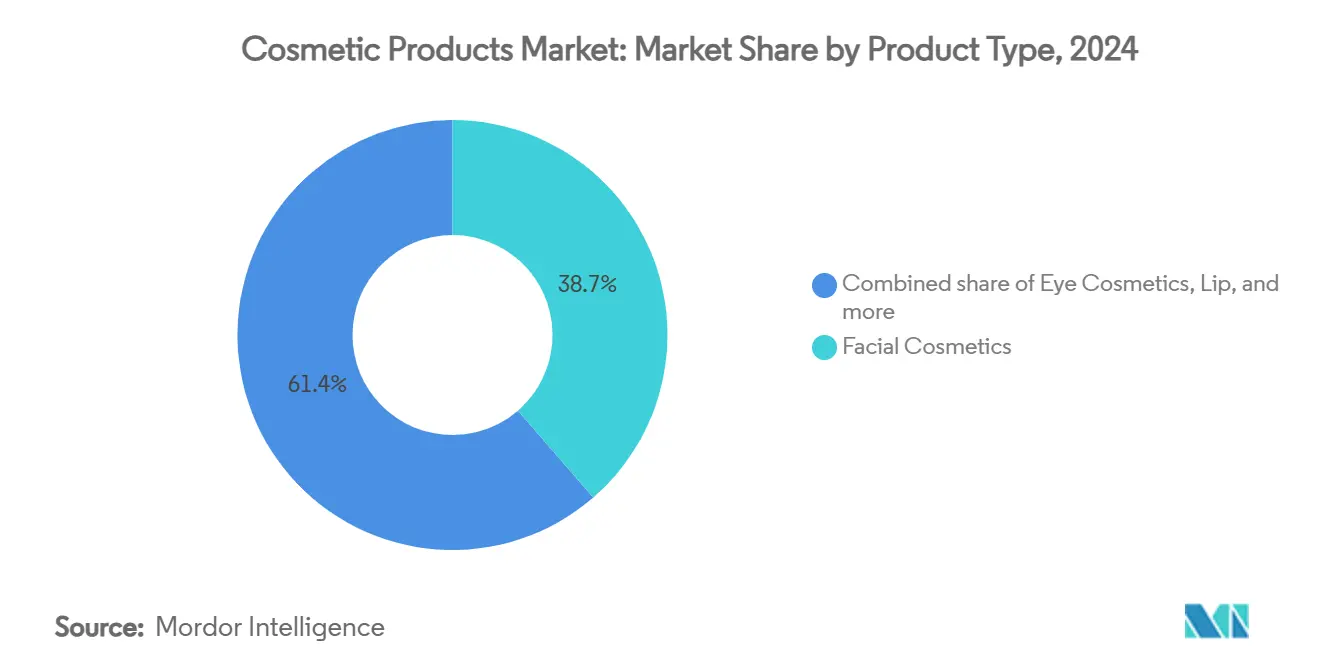
Note: Segment shares of all individual segments available upon report purchase
By Category: Premium Segment Accelerates
By 2030, premium offerings are set to grow at a robust CAGR of 5.35%, outpacing the mass trade segment's growth. In 2024, the mass trade segment held a significant 58.34% share of the cosmetics market. In the Asia-Pacific and Middle East regions, an expanding base of aspirational consumers is gravitating towards prestige formulations. These formulations not only offer sensory appeal but also prioritize clean and sustainable ingredients, aligning with the increasing demand for environmentally conscious and health-focused products. This trend highlights a shift in consumer preferences towards high-quality, innovative products that cater to both aesthetic and ethical considerations. In a testament to the sector's emphasis on technology-driven differentiation, Estée Lauder has forged a strategic partnership with Exuud. Their goal is to commercialize the Soliqaire TM fragrance delivery system, which enhances fragrance longevity and sensory experience, marking a significant leap in product innovation within the premium cosmetics arena.
Premium brands are harnessing loyalty programs, crafting personalized omnichannel experiences, and unveiling exclusive limited-edition product launches. These strategies not only bolster their pricing power but also deepen customer engagement by creating a sense of exclusivity and fostering brand loyalty. Meanwhile, mass-market players are rolling out sub-premium product extensions, aiming to capture consumers who are moving towards higher-value offerings. In 2024, the Organisation for Economic Co-operation and Development spotlighted Luxembourg, noting its household net adjusted annual disposable income in Europe stood at USD 44.77 thousand[2]Source: International Trade Administration, "Singapore Beauty and Personal Care Market", www.trade.gov. This uptick in disposable income has emboldened consumers, especially young professionals and urbanites, to gravitate towards premium cosmetics. They're now opting for luxury items, like high-end lipsticks and foundations, leaving mass-market choices behind. This shift reflects a growing inclination towards products that not only deliver superior performance but also align with the aspirational lifestyles of these consumer groups.
By Ingredient Type: Natural Transformation Accelerates
In 2024, natural and organic product lines, expanding at a 6.35% CAGR, are gradually eroding the 70.34% market share once dominated by conventional and synthetic inputs in the cosmetics sector. The USDA organic certification mandates rigorous crop-to-counter documentation, including three-year land preparation, meticulous lot-level records, and electronic import permits. These stringent standards predominantly favor multinational manufacturers boasting vertically integrated supply chains, as they are better equipped to meet complex requirements and maintain compliance. Smaller players often face challenges in meeting these standards due to limited resources and lack of infrastructure, which further consolidates the market power of larger companies.
To navigate tightening global substance regulations, organizations are channeling resources into agri-based feedstocks, fermentation technologies, and green chemistry. Investments in these areas not only ensure regulatory compliance but also align with the growing consumer demand for sustainable and eco-friendly products. For instance, agri-based feedstocks provide renewable raw materials, while fermentation technologies enable the production of high-performance ingredients with reduced environmental impact. Green chemistry focuses on designing processes and products that minimize hazardous substances. Today's marketing strategies prioritize transparency, frequently utilizing QR codes to unveil origin stories and life-cycle assessments, thereby building consumer trust. With natural pigments and bio-based actives closing the performance gap with their synthetic counterparts, brands are seamlessly transitioning to fully sustainable product lines while bolstering narratives centered on environmental responsibility and long-term sustainability goals. This shift not only enhances brand reputation but also positions companies to meet evolving regulatory and consumer expectations effectively.
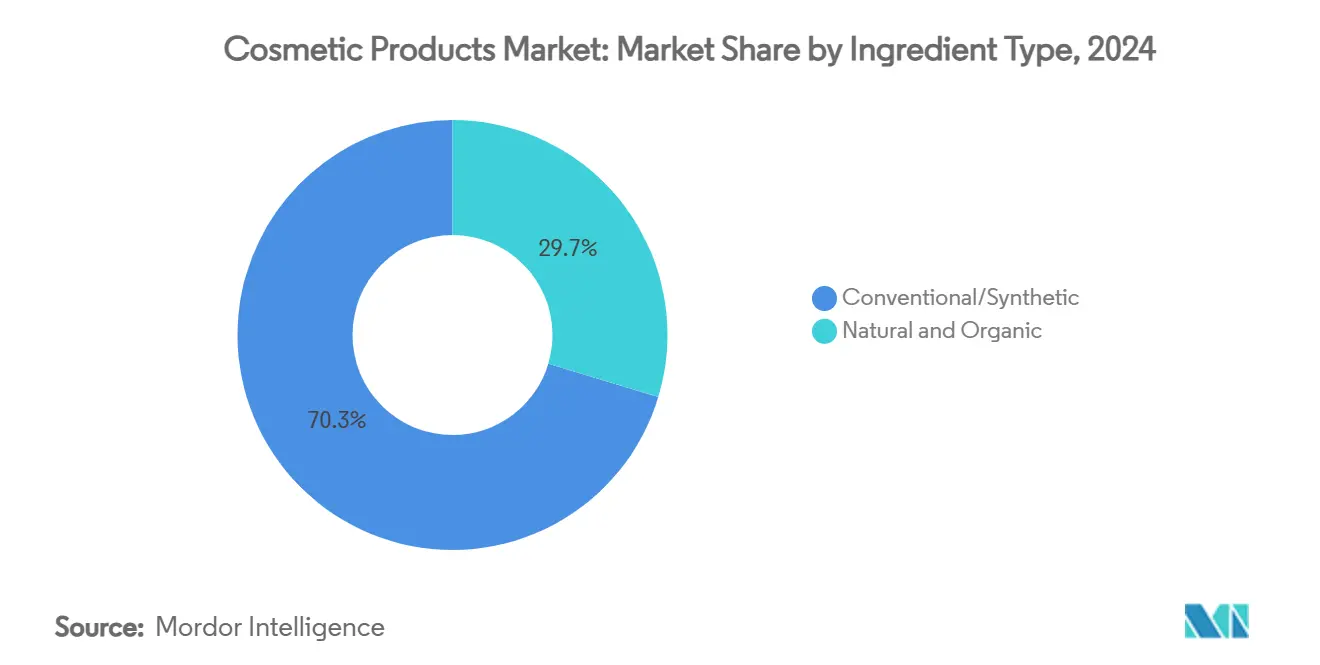
By Distribution Channel: Digital Commerce Transforms Retail
Online retail stores are set to outpace traditional brick-and-mortar formats, with a projected annual growth rate of 6.95%. Meanwhile, specialty stores are poised to command a notable 40.23% share of the cosmetics market in 2024. This momentum is fueled by innovations like AI-driven personalization, which tailors product recommendations to individual preferences, virtual try-on features that allow customers to visualize products before purchase, and enhanced last-mile logistics that expedite deliveries and improve customer satisfaction. Highlighting the power of first-party data, Unilever's global initiative on ultra-personalized customer journeys showcases its role in boosting customer lifetime value, improving customer retention, and refining marketing spending by targeting the right audience more effectively.
Counterfeit threats remain a pressing concern for the industry. In response, brands are launching direct-to-consumer platforms to establish greater control over their supply chains and leveraging blockchain seals to guarantee product authenticity, thereby building consumer trust. To boost foot traffic, brick-and-mortar stores are weaving in experiential features like skin diagnostics, which provide personalized skincare insights, and tutorial zones, where customers can learn about product applications and techniques, making shopping more interactive and informative. Furthermore, leading market players are embracing hybrid retail methods, ranging from click-and-collect services that combine online convenience with in-store pickup, live-stream shopping events that offer real-time engagement, to subscription refill models that ensure consistent product availability, mirroring the shifting tastes and expectations of today's consumers.
Geography Analysis
In 2024, North America captured 33.43% of the global revenue share, driven by well-established consumption patterns and a strong presence in the premium segment. The implementation of the Modernization of Cosmetics Regulation Act (MoCRA) in January 2025 will introduce mandatory facility registration and product listing requirements, leading to increased compliance costs. This regulatory shift is expected to consolidate market positions among larger manufacturers with the resources to adapt. Future growth in the region is anticipated to be propelled by advancements in AI-driven personalization, which will enable tailored consumer experiences, and the adoption of sustainable packaging solutions to address environmental concerns and counteract market saturation.
Directive 2024/825, set to take effect in September 2025, aims to tighten regulations across Europe by banning ambiguous eco-claims and certain substances. This directive is expected to create a more stringent regulatory framework, compelling companies to enhance their compliance strategies. Established players with strong regulatory expertise and compliance capabilities are likely to gain a competitive edge in navigating these changes. Furthermore, with rising disposable incomes, markets in Central and Eastern Europe, such as Lithuania, Hungary, and Bulgaria, are witnessing rapid growth. This growth underscores lucrative expansion opportunities, as increased consumer spending on cosmetics drives demand in these regions.
The Asia-Pacific region is projected to achieve the highest regional compound annual growth rate (CAGR) of 7.53% during the forecast period of 2025 to 2030. In China, the 2025 National Medical Products Administration (NMPA) provisions aim to simplify ingredient approval processes, thereby reducing the time to market for innovative active ingredients. Local brands, which are adept at aligning with cultural preferences, are scaling operations rapidly. However, multinational companies maintain a competitive edge due to their technological advancements and efficient multi-country logistics networks. Countries such as India, China, Indonesia, and Vietnam, characterized by large and youthful populations, present substantial growth potential. According to the World Bank, 68.02% of India’s population fell within the 15-64 age group in 2024[3]Source: Organization for Economic Co-operation and Development. "OECD Better life index -Income". www.oecd.org. This younger demographic is increasingly beauty-conscious, trend-aware, and open to experimentation, driving robust demand for skin care products, color cosmetics, and offerings inspired by K-beauty and J-beauty trends.
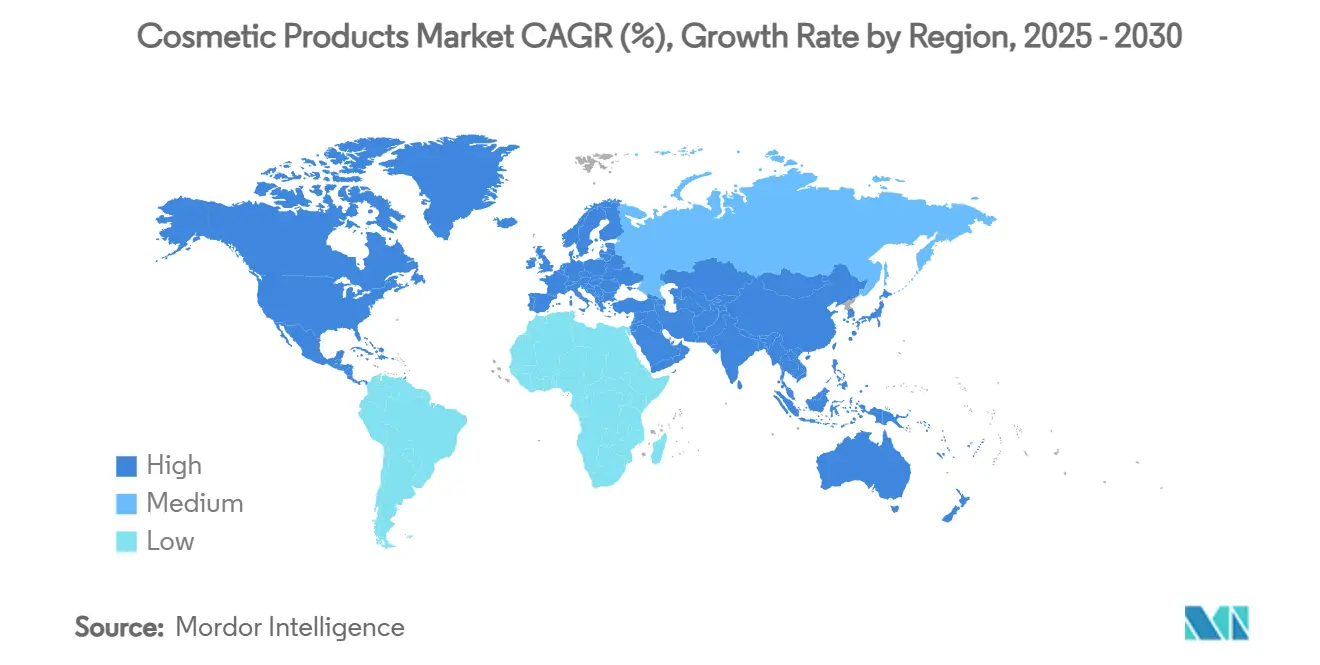
Competitive Landscape
The cosmetic market is moderately consolidated. Multinational corporations dominate the cosmetics market, but indie brands are effectively utilizing digital channels to establish a competitive presence. The major players include L’Oréal SA, Unilever Plc, Shiseido Company Limited, The Estée Lauder Companies, and Revlon Inc. Companies are increasingly adopting shared procurement strategies for ethically sourced raw materials to achieve scalability in sustainable supply chains. Additionally, with ambitious carbon-reduction commitments, these corporations are emphasizing environmental responsibility as a core component of both investor relations and consumer engagement.
The cosmetics market is moderately concentrated, with global leaders leveraging economies of scale in research and development, regulatory compliance, and omnichannel distribution to secure significant market shares. Companies capable of managing multi-jurisdictional regulatory requirements while sustaining rapid innovation are well-positioned to gain a competitive edge as the industry increasingly focuses on technological advancements and compliance expertise.
Strategic priorities include expanding direct-to-consumer platforms, acquiring niche clean-beauty brands, and making substantial investments in data analytics to enable hyper-personalization. Regulatory tightening under MoCRA and EU chemical reforms is raising entry barriers, reinforcing the dominance of established players. However, agile disruptors utilizing micro-influencer networks and biotech ingredients are successfully capturing market share in high-growth sub-segments.
Cosmetic Products Industry Leaders
-
The Estée Lauder Companies Inc.
-
L'Oréal S.A.
-
Revlon, Inc.
-
Shiseido Co. Ltd.
-
Unilever PLC
- *Disclaimer: Major Players sorted in no particular order
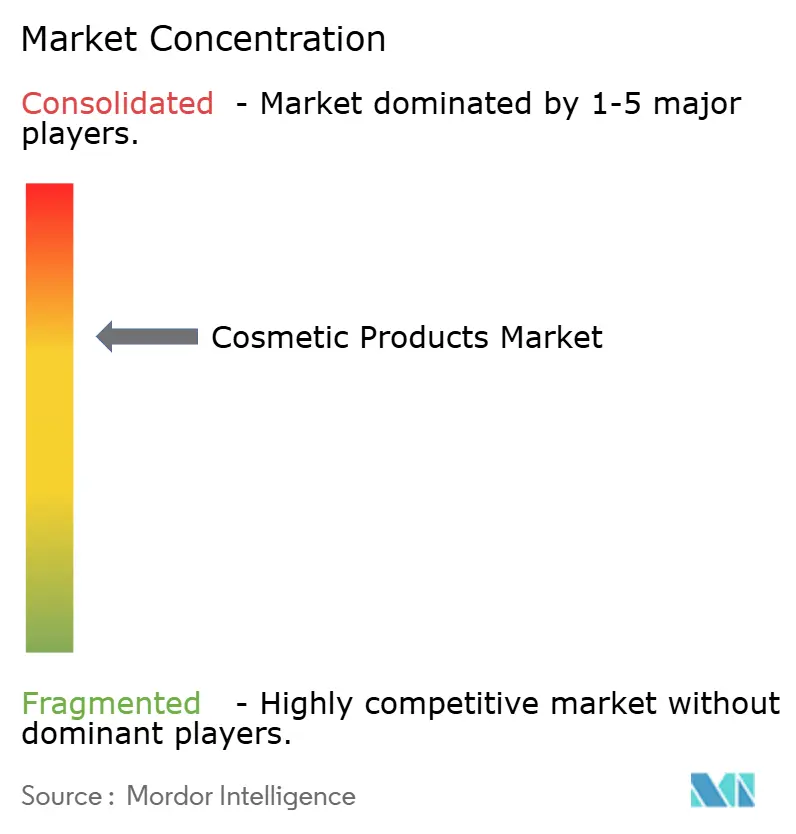
Recent Industry Developments
- April 2025: Chanel, led by visionary makeup artist Ammy Drammeh of ComètesCollective, introduced its Spring/Summer 2025 makeup collection. This launch strategically redefines the brand's aesthetic codes by incorporating bold and vibrant colors to mark the beginning of the new year.
- March 2025: Louis Vuitton launched its beauty products line in the fall of 2025. The launch collection featured 55 lipsticks, 10 lip balms, and 8 eyeshadow palettes, which were distributed across more than 100 Louis Vuitton retail locations worldwide.
- February 2025: L'Oréal Groupe formed a long-term exclusive beauty partnership with JACQUEMUS and made a minority investment to support JACQUEMUS's independent development.
- March 2024: Armani Beauty launched Prisma Glass, a beauty product line. The introduction of PRISMA GLASS marked a new dimension in the lip makeup segment: a combination of high gloss effect and innovative oil-in-gloss technology, resulting in a multidimensional finish, both in terms of volume and shine.
Global Cosmetic Products Market Report Scope
Beauty and personal care products and practices focus on enhancing physical appearance and upholding personal hygiene. The beauty and personal care market report is segmented into product type, category, ingredient type, distribution channel, and geography. Based on product types, the market is segmented into personal care and cosmetics / make-up products. The personal care segment is further segmented into hair care, skin care, bath & shower, oral care, men’s grooming products, deodorants & antiperspirants, and perfumes & fragrances. The cosmetics/make-up products segment is further segmented into facial cosmetics, eye cosmetics, and lip & nail make-up products. Based on category, the market is segmented into premium products and mass products. Based on ingredient type, the market is segmented into natural & organic and conventional. Based on distribution channels, the market is segmented into supermarkets/hypermarkets, specialty stores, online retail stores, and other distribution channels. Based on geography the market is segmented into North America, Europe, Asia Pacific, South America, and the Middle east and Africa. The market sizing has been done in value terms in USD for all the abovementioned segments.
| Facial Cosmetics |
| Eye Cosmetics |
| Lip and Nail Make-up Products |
| Premium Products |
| Mass Products |
| Natural and Organic |
| Conventional/Synthetic |
| Specialty Stores |
| Supermarkets/Hypermarkets |
| Online Retail Stores |
| Other Channels |
| North America | United States |
| Canada | |
| Mexico | |
| Rest of North America | |
| Europe | United Kingdom |
| Germany | |
| Spain | |
| France | |
| Italy | |
| Russia | |
| Rest of Europe | |
| Asia-Pacific | China |
| Japan | |
| India | |
| Australia | |
| Rest of Asia-Pacific | |
| South America | Brazil |
| Argentina | |
| Rest of South America | |
| Middle East and Africa | Saudi Arabia |
| South Africa | |
| Rest of Middle East and Africa |
| By Product Type | Facial Cosmetics | |
| Eye Cosmetics | ||
| Lip and Nail Make-up Products | ||
| By Category | Premium Products | |
| Mass Products | ||
| By Ingredient Type | Natural and Organic | |
| Conventional/Synthetic | ||
| By Distribution Channel | Specialty Stores | |
| Supermarkets/Hypermarkets | ||
| Online Retail Stores | ||
| Other Channels | ||
| By Geography | North America | United States |
| Canada | ||
| Mexico | ||
| Rest of North America | ||
| Europe | United Kingdom | |
| Germany | ||
| Spain | ||
| France | ||
| Italy | ||
| Russia | ||
| Rest of Europe | ||
| Asia-Pacific | China | |
| Japan | ||
| India | ||
| Australia | ||
| Rest of Asia-Pacific | ||
| South America | Brazil | |
| Argentina | ||
| Rest of South America | ||
| Middle East and Africa | Saudi Arabia | |
| South Africa | ||
| Rest of Middle East and Africa | ||
Key Questions Answered in the Report
What is the current size of the cosmetics market?
The cosmetics market size stands at USD 80.54 billion in 2025 and is projected to reach USD 98.44 billion by 2030.
Which region is growing the fastest in the cosmetics market?
Asia-Pacific leads with a forecast 7.53% CAGR between 2025 and 2030 owing to rising disposable income and mobile commerce adoption.
How is MoCRA affecting cosmetics manufacturers in the United States?
MoCRA introduces mandatory facility registration, product listing, and adverse-event reporting, raising compliance costs and favoring firms with robust regulatory systems.
Why are natural and organic cosmetics growing quickly?
Regulatory standards such as USDA’s National Organic Program and heightened consumer demand for transparent sourcing are propelling the natural and organic segment at a 6.35% CAGR to 2030.
Page last updated on:
